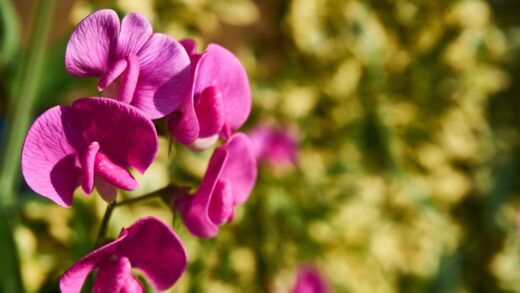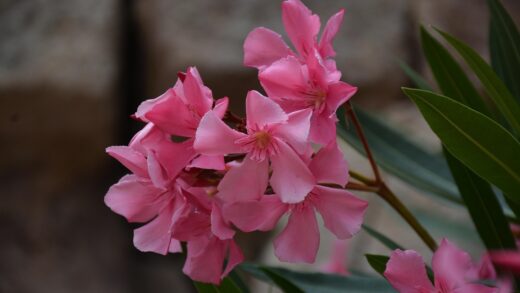Successfully establishing a lemon-scented geranium begins with a thoughtful approach to its initial planting, a process that sets the stage for its entire life cycle. This foundational step is about more than simply placing the plant in soil; it involves selecting the right location, preparing the perfect growing medium, and handling the young plant with care to minimize stress. A well-executed planting ensures the root system can establish itself quickly and efficiently, providing a stable anchor and the primary means for water and nutrient uptake. This initial care and attention to detail will be rewarded with a resilient and vigorously growing plant that is better equipped to thrive in its new environment.
The transition from a nursery pot to a permanent home, whether in a container or a garden bed, is a critical moment for any plant. For the lemon-scented geranium, which is particularly sensitive to ‘wet feet’, the preparation of the planting site is paramount. This involves ensuring that the soil structure allows for exceptional drainage while still retaining adequate moisture. The goal is to create a welcoming environment where the roots are encouraged to spread out and explore, rather than being confined by compacted soil or threatened by waterlogged conditions. Proper planting is an investment in the plant’s future health and vitality.
Beyond the physical act of planting, understanding the plant’s inherent needs is crucial. Lemon-scented geraniums prosper when they receive ample sunlight and are situated in a location with good air circulation to ward off potential fungal issues. Therefore, site selection is a strategic decision that directly impacts the plant’s long-term success. Choosing a spot that meets these requirements from the outset prevents the need to relocate the plant later, which can cause unnecessary stress and set back its growth. Thoughtful placement is a proactive measure that fosters a robust and aromatic specimen.
Once planted, the initial aftercare is just as important. The plant will undergo a period of adjustment as its roots begin to acclimate to the new soil. During this time, it’s essential to monitor moisture levels carefully, providing consistent but not excessive water to help settle the soil and support the root establishment process. This careful attention during the initial weeks post-planting will lay a strong foundation, enabling the lemon-scented geranium to flourish and fill your garden with its delightful citrus scent for years to come.
Choosing the right location
Selecting the perfect spot for your lemon-scented geranium is the first and perhaps most important step in the planting process. This plant is a sun-lover at heart, requiring a position that receives at least six hours of direct sunlight per day. In regions with very hot summers, a location that offers bright morning sun and some light afternoon shade is ideal, as this protects the plant from the most intense heat, which can cause leaf scorch and stress. For indoor cultivation, a south-facing windowsill is the prime choice, providing the bright light necessary for dense growth and a strong fragrance.
More articles on this topic
Good air circulation is another critical factor to consider when choosing a location. Stagnant, humid air can create a breeding ground for fungal diseases like botrytis and powdery mildew, to which geraniums can be susceptible. Planting in an area with a gentle breeze or ensuring adequate space between plants allows the foliage to dry quickly after rain or watering, significantly reducing the risk of these issues. When growing indoors, avoid placing the plant in a stuffy corner; instead, choose a spot where the air moves more freely.
When planting directly into a garden bed, it is crucial to assess the soil conditions of the chosen location. Lemon-scented geraniums demand well-draining soil and will not tolerate heavy clay soils that retain water. If your garden soil is dense, you will need to amend it generously with organic matter such as compost, along with grit or coarse sand to improve its structure and drainage. Alternatively, consider planting in a raised bed, which provides an excellent solution for creating the ideal soil environment with superior drainage.
For container planting, the choice of location is more flexible, as you can move the pot to find the perfect spot. This allows you to adjust the plant’s position with the changing seasons, for example, moving it to a sunnier spot in the spring and a slightly more protected one during the peak of summer. The ability to control its environment more precisely is a significant advantage of container gardening, but the fundamental requirements for sunlight and air circulation remain the same regardless of whether the plant is in a pot or in the ground.
Preparing the soil and container
Whether you are planting in the ground or in a container, preparing the soil correctly is non-negotiable for a healthy lemon-scented geranium. The primary goal is to create a growing medium that is light, airy, and drains exceptionally well. For garden beds, start by loosening the soil to a depth of at least 30 centimeters. Then, incorporate a generous amount of organic material, such as compost or well-rotted leaf mold, and a material like coarse horticultural sand or fine gravel to improve the soil’s porosity and prevent waterlogging around the root zone.
More articles on this topic
When planting in containers, you have complete control over the growing medium, which is a significant advantage. It is strongly recommended to use a high-quality, sterile potting mix rather than garden soil, which can be heavy, contain weed seeds, and harbor pathogens. A commercial mix designed for cacti and succulents, or a general-purpose potting mix amended with one-third perlite or pumice, will provide the fast drainage that these plants crave. This ensures that even after a thorough watering, the roots will have access to the oxygen they need to thrive.
The choice of container itself is also an important consideration. Ensure that any pot you select has multiple drainage holes at the bottom to allow excess water to escape freely. Terracotta pots are often an excellent choice because their porous nature allows for air and moisture exchange through the sides of the pot, helping the soil to dry out more evenly. If you use a plastic or glazed ceramic pot, which retains moisture longer, you must be even more diligent about checking the soil’s moisture level before watering again.
Before filling your chosen container, it can be beneficial to cover the drainage holes with a piece of mesh screen or a few broken pot shards. This prevents the potting mix from washing out of the bottom while still allowing water to drain away. Fill the pot with your prepared soil mix, leaving enough space at the top to accommodate the plant’s root ball. It is generally not recommended to add a layer of gravel to the bottom of the pot, as this can actually impede drainage by creating a perched water table within the container.
The planting process step-by-step
Once you have selected your location and prepared the soil, you are ready for the actual planting. Begin by carefully removing the lemon-scented geranium from its nursery pot. To do this, gently tip the pot on its side and tap the bottom and sides to loosen the root ball. Avoid pulling the plant out by its stem, as this can cause damage; instead, support the base of the plant with one hand while sliding the pot off with the other. This gentle handling minimizes transplant shock and helps the plant acclimate more quickly.
Next, inspect the root ball. If the roots are tightly coiled and compacted, a condition known as being root-bound, it is important to gently tease them apart with your fingers. This encourages the roots to grow outwards into the new soil rather than continuing to circle in their old shape. If the roots are particularly dense, you can make a few shallow vertical cuts into the sides of the root ball with a clean knife to stimulate new root growth.
Dig a hole in your prepared garden bed or container that is slightly wider and just as deep as the plant’s root ball. Place the plant into the hole, ensuring that the top of the root ball is level with the surrounding soil surface. Planting too deep can lead to stem rot, while planting too high can expose the roots and cause them to dry out. Backfill the hole with soil, gently firming it down around the root ball to eliminate any large air pockets.
After the plant is securely in place, water it thoroughly. This initial watering is crucial as it helps to settle the soil around the roots and provides the moisture needed to begin the establishment process. Water until you see it running freely from the drainage holes of a container, or until the soil in a garden bed is deeply moistened. For the first few weeks, monitor the plant closely and keep the soil consistently moist but not saturated, allowing the top centimeter or two of soil to dry out before watering again.
Propagation from stem cuttings
Propagating the lemon-scented geranium from stem cuttings is a remarkably simple and effective way to create new plants. This method not only allows you to easily increase your stock but also produces a new plant that is genetically identical to the parent. The best time to take cuttings is during the spring or early summer when the parent plant is in a state of active growth. This ensures that the cuttings are vigorous and have the best chance of developing a healthy root system.
To take a cutting, select a healthy, non-flowering stem from the parent plant. Using a clean, sharp knife or pruning shears, make a cut about 8 to 12 centimeters long, just below a leaf node (the point on the stem where a leaf grows). The presence of this node is critical, as this is where the new roots will emerge. Once you have your cutting, carefully remove the leaves from the lower half of the stem, leaving just two or three leaves at the very top.
While not strictly necessary, dipping the cut end of the stem into a rooting hormone powder can increase the success rate and speed up the rooting process. The hormone encourages the development of new roots from the cut surface. Tap off any excess powder, as too much can be counterproductive. This step provides a helpful boost, particularly for cuttings that might be a bit slower to root on their own.
Insert the prepared cutting into a small pot filled with a light, well-draining rooting medium, such as a mix of perlite and peat moss or coarse sand. The cutting should be inserted deep enough so that at least one or two of the stripped leaf nodes are below the soil surface. Water the medium lightly, place the pot in a location with bright, indirect light, and keep the soil consistently moist but not waterlogged. In a few weeks, the cutting should develop roots, which you can test for by giving a very gentle tug; if you feel resistance, roots have formed, and your new plant is on its way.
Propagation by division
Division is another straightforward method for propagating mature lemon-scented geraniums, particularly those that have become large and perhaps a bit overgrown in their pots. This process involves separating a large parent plant into two or more smaller sections, each with its own set of roots and stems. The ideal time to divide your geranium is in the early spring, just before the new season’s growth begins in earnest. This timing gives the new divisions a full growing season to establish themselves before the onset of winter.
To begin the process, carefully remove the entire plant from its pot or lift it from the garden bed. Gently shake or brush off the excess soil from the root ball so that you can clearly see the root structure and the points where the plant naturally separates. Look for distinct clumps or crowns of stems that have their own substantial root systems. The goal is to identify viable sections that can be separated without causing excessive damage to the parent plant.
Using your hands, gently tease the root ball apart into smaller sections. For tougher, more entangled root systems, you may need to use a clean, sharp knife or a spade to make clean cuts through the crown and roots. Ensure that each new division has a healthy portion of both stems and roots attached. Try to make the divisions as even as possible to give each new plant a good start, discarding any sections that look weak or have damaged roots.
Once you have your divisions, you can plant them immediately into new pots or prepared locations in the garden. Plant them at the same depth they were growing at previously and fill in with fresh, well-draining soil. Water the newly potted divisions thoroughly to settle the soil and then care for them as you would a mature plant, although you may want to keep them in a slightly more protected location out of direct, intense sunlight for a week or two as they recover from the stress of the division process.




















